
Guillaume Seignac stands as a significant figure in the landscape of late 19th and early 20th-century French art. Born in 1870 and passing away in 1924, his life spanned a period of immense artistic change, yet he remained steadfastly dedicated to the principles of Academic Classicism. Trained under some of the most renowned masters of the era, Seignac developed a distinctive style characterized by technical brilliance, idealized beauty, and a deep engagement with classical antiquity. His works, often featuring mythological themes and exquisitely rendered female figures, found favour with audiences and critics alike, earning him accolades and ensuring his presence in prestigious exhibitions. Though the tides of modernism eventually shifted artistic tastes, Seignac's art retains a powerful allure, admired for its elegance, craftsmanship, and evocative portrayal of a timeless, idealized world.
Formative Years: The Path to Academic Mastery
Guillaume Seignac's artistic journey began in Rennes, France, where he was born in 1870. Demonstrating artistic inclinations early on, he pursued formal training in the heart of the French art world, Paris. Around 1889 or 1890, he enrolled at the prestigious Académie Julian, a private art school that served as a vital training ground for many artists, offering an alternative or supplement to the official École des Beaux-Arts. The Académie Julian was renowned for its rigorous curriculum, emphasizing drawing from life, anatomy, perspective, and the study of Old Masters – the cornerstones of Academic training.
At the Académie Julian, Seignac had the invaluable opportunity to study under several highly respected and influential painters of the time. Chief among them was William-Adolphe Bouguereau, a towering figure in 19th-century French Academic art. Bouguereau's meticulous technique, smooth finish, and idealized depictions of mythological and genre scenes profoundly impacted Seignac's development. The emphasis on flawless rendering of the human form, particularly the female nude, became a hallmark of Seignac's own work, echoing his master's style.
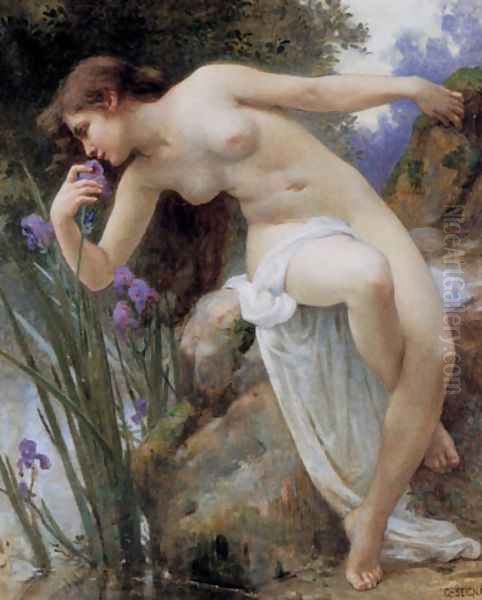
Seignac also benefited from the tutelage of Tony Robert-Fleury, another prominent Academic painter known for his historical subjects and portraits, and Gabriel Ferrier, celebrated for his portraits and Orientalist scenes. Instruction under these masters provided Seignac with a comprehensive grounding in Academic principles and techniques. He absorbed the importance of precise draughtsmanship, balanced composition, and the skillful manipulation of light and shadow to create convincing, idealized representations. This intensive training, lasting until around 1895, equipped Seignac with the technical arsenal and aesthetic framework that would define his artistic career.
The Essence of Seignac's Art: Style, Themes, and Technique
Guillaume Seignac's artistic output is firmly rooted in the French Academic tradition, showcasing a profound reverence for Classicism and the ideals of the Renaissance. His style is characterized by meticulous draughtsmanship, a smooth, polished finish, and idealized representations, particularly of the female form. He drew inspiration from classical antiquity and Renaissance masters like Sandro Botticelli and Michelangelo, as well as Baroque painters such as Nicolas Poussin and Peter Paul Rubens, integrating their influence into a style that was both traditional and possessed a distinct elegance.
Thematically, Seignac frequently explored subjects drawn from Greek and Roman mythology and allegory. Figures like Cupid, Psyche, Venus, and Diana populate his canvases, often depicted in narrative scenes that highlight classical virtues or explore timeless human emotions. He excelled at creating allegorical works, personifying abstract concepts like contemplation or reverie through graceful female figures posed thoughtfully within serene settings. These settings often included classical architectural elements, such as Roman fountains, Pompeian benches, or Greek vases, reinforcing the antique atmosphere and providing context for his figures.
A particularly distinctive feature of Seignac's technique is his masterful rendering of transparent fabrics and diaphanous veils. He often draped his idealized female nudes in light, flowing materials that simultaneously conceal and reveal the form beneath, a technique reminiscent of the sculpted drapery of Phidias on the Parthenon or the delicate fabrics in Botticelli's paintings. This allowed him to showcase his skill in depicting the human body while maintaining an aura of classical modesty and grace. His compositions are typically balanced and harmonious, with clear outlines and a careful arrangement of forms within the picture plane.
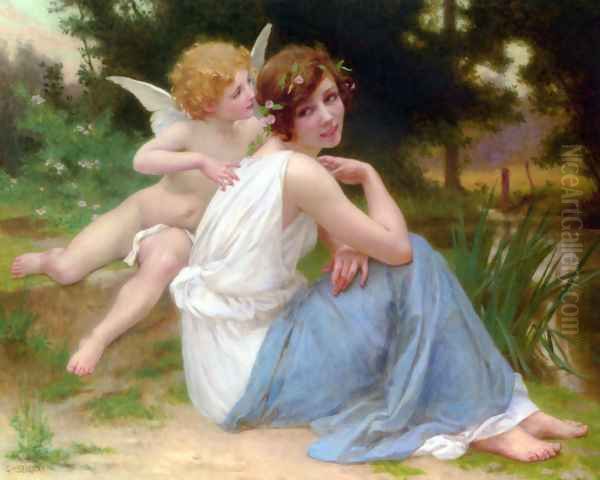
In his use of color and light, Seignac demonstrated considerable skill. Works like The Fragrant Iris exemplify his ability to employ fresh, vibrant, yet elegant palettes. He often used light to model forms softly, creating subtle transitions between light and shadow that enhance the sense of volume and realism, while ensuring the main subject stands out clearly against the background. While firmly Academic, some observers note a sensitivity in his work to the decorative qualities and flowing lines associated with the burgeoning Art Nouveau movement, suggesting an awareness, if not a full embrace, of contemporary aesthetic currents.
A Celebrated Career: Exhibitions and Accolades
Having honed his skills under the guidance of masters like Bouguereau, Seignac embarked on his professional career around 1895. He quickly sought recognition within the established art institutions of Paris, primarily through the official Salons. Beginning in 1897, he became a regular exhibitor at the Salon des Artistes Français, the successor to the original Paris Salon and the most important venue for Academic artists to display their work and gain patronage.
His participation in the Salon was consistent, indicating both his productivity and the acceptance of his work by the Salon juries, which upheld traditional Academic standards. Seignac's paintings, with their classical themes, technical polish, and idealized beauty, aligned well with the prevailing tastes favoured by the Salon establishment and its patrons. His skillfully rendered nudes and mythological scenes appealed to collectors seeking art that embodied beauty, tradition, and high craftsmanship.
Seignac's talent did not go unnoticed. His work received official recognition in the form of Salon awards, which were crucial markers of success for artists of the period. In 1900, he was awarded an Honorable Mention, a significant acknowledgement of his skill. This was followed in 1903 by a Third Class Medal, further cementing his reputation as a painter of considerable merit within the Academic hierarchy. These awards enhanced his visibility and likely contributed to his commercial success.
Beyond the regular Salons, Seignac also participated in other significant exhibitions. Notably, his work was included in the Exposition Universelle held in Paris in 1900. This major international exhibition was a showcase for achievements in industry, science, and the arts, and participation offered artists exposure to a vast international audience. Seignac's presence there underscores his standing in the French art scene at the turn of the century. Interestingly, some sources suggest his work appealed not only to traditional buyers but also attracted attention from collectors interested in the "curvilinear seductions" of Art Nouveau, indicating a broader appeal than might be expected from a purely Academic painter.
Market Recognition and Patronage
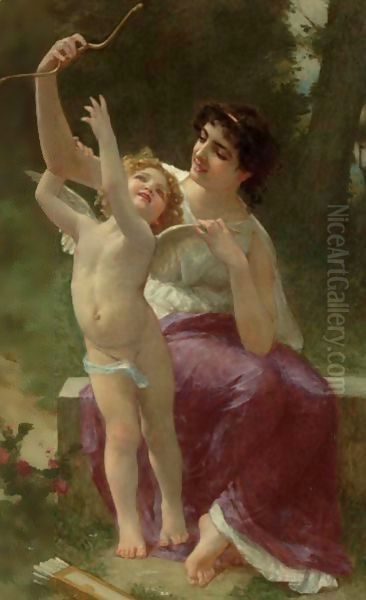
Throughout his active career, particularly in the years leading up to World War I and into the early 1920s, Guillaume Seignac enjoyed considerable success in the art market. His paintings found buyers not only in Paris but also in major international art centres like London and New York. The appeal of his work lay in its combination of technical virtuosity, adherence to classical ideals of beauty, and accessible, often charming, subject matter.
Collectors who favoured Academic art appreciated his continuation of the tradition exemplified by his teacher, Bouguereau. The idealized female figures, mythological narratives, and allegorical scenes resonated with patrons seeking art that was both aesthetically pleasing and rooted in established European cultural traditions. The high level of finish and evident skill in his paintings also signified quality and value to potential buyers.
The market for Academic art, while facing challenges from emerging modernist movements, remained robust during Seignac's lifetime. His regular exhibition at the Salon and the awards he received likely translated into steady sales and commissions. While specific details of his patronage are not extensively documented in the provided sources, the consistent production and exhibition of his work suggest a reliable base of collectors.
Even after his death in 1924, Seignac's work continued to be traded, although the art market experienced fluctuations due to events like the Great Depression. Sources indicate a dip in sales followed his passing but note a recovery by the 1940s. In more recent times, there has been a resurgence of interest in 19th-century Academic art, and Seignac's paintings have performed well at auction. A notable example is the sale of his painting The Bather at Artcurial in 2018 for €400,000 (approximately $468,000 USD), demonstrating the significant value his works command in the contemporary art market and their enduring appeal to collectors.
Masterworks: Visions of Antiquity and Ideal Beauty
Guillaume Seignac left behind a substantial body of work, much of which exemplifies his dedication to classical themes and idealized beauty. Several paintings are frequently cited as representative of his style and skill.
The Fragrant Iris is often highlighted. This work showcases his delicate handling of colour, the graceful pose of the female figure, and potentially his characteristic use of light drapery, embodying the elegance and charm found in many of his paintings. The title itself suggests a connection to nature and sensory beauty, common elements in Academic genre scenes.
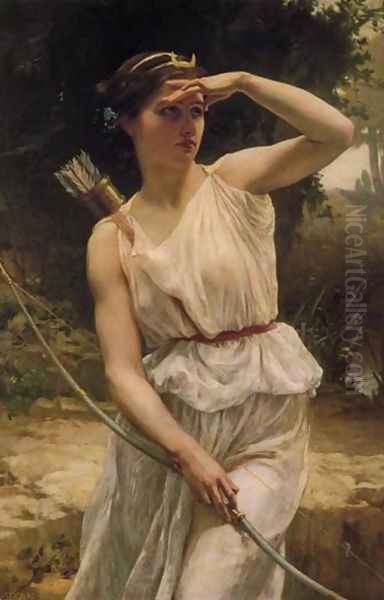
Mythological subjects form a core part of his oeuvre. Works such as Cupid and Psyche, Venus and Cupid, and Diana Hunting allowed Seignac to engage directly with classical narratives. These paintings typically feature idealized figures set within lush landscapes or classical interiors, rendered with the smooth finish and anatomical precision characteristic of his training under Bouguereau. They offered viewers familiar stories presented with technical refinement and aesthetic grace.
Paintings focusing primarily on the female form, often in states of undress or repose, were also central to his output. Titles like Reclining Odalisque, Nude on the Beach, and The Bather point to this recurring theme. While the term "Odalisque" evokes Orientalist themes popularised by artists like Jean-Auguste-Dominique Ingres and later Jean-Léon Gérôme, Seignac typically placed his figures within more generalized classical or natural settings. These works celebrate an idealized female beauty, emphasizing graceful lines, smooth skin, and serene expressions, often employing the signature transparent veils.
His interest in classical settings is evident in works like Woman on a Pompeian Terrace (or Pompeian Lady). Here, the backdrop of Pompeian architecture provides an authentic classical context for the figure, enhancing the historical or mythological atmosphere. Across these various works, common threads emerge: technical polish, a preference for idealized rather than realistic portrayal, balanced compositions, and a mood of tranquility and timeless beauty. While many specific locations are now private collections, these titles represent the types of works that cemented Seignac's reputation.
Seignac in His Time: Context and Connections
Guillaume Seignac practiced his art during a dynamic and often contentious period in French art history. The late 19th and early 20th centuries witnessed the entrenched dominance of the Academic tradition, represented by the official Salons and institutions like the École des Beaux-Arts, alongside the rise and consolidation of revolutionary movements that challenged its very foundations. Seignac firmly belonged to the Academic camp, upholding its values of technical skill, historical subject matter, and idealized representation.
His teachers – William-Adolphe Bouguereau, Tony Robert-Fleury, and Gabriel Ferrier – were leading figures of this establishment. Other prominent Academic contemporaries included painters like Jean-Léon Gérôme, known for his historical and Orientalist scenes, and Alexandre Cabanel, whose Birth of Venus was a sensation at the Salon. The British painter Lawrence Alma-Tadema, though not French, worked in a related vein, meticulously recreating scenes from classical antiquity. These artists shared a commitment to high finish, detailed realism (within an idealized framework), and often drew upon historical or mythological sources.
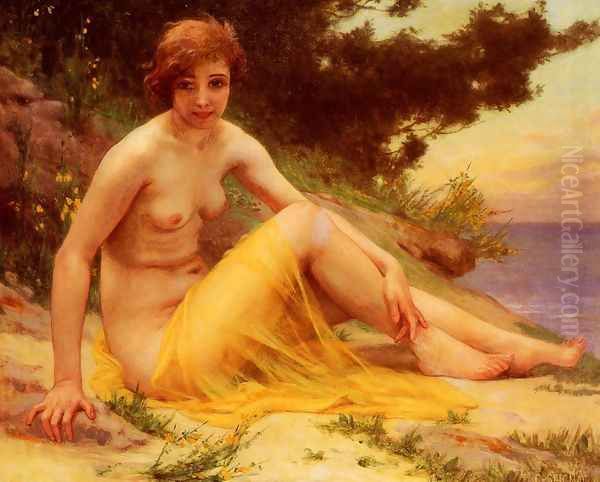
However, this was also the era of Impressionism and Post-Impressionism. Artists like Claude Monet, Edgar Degas, and Pierre-Auguste Renoir had already revolutionised painting with their focus on capturing fleeting moments, the effects of light, and modern life, using looser brushwork and brighter palettes. Following them, Post-Impressionists such as Paul Cézanne, Vincent van Gogh, and Paul Gauguin pushed artistic boundaries further, exploring structure, emotion, and symbolism in ways that diverged radically from Academic norms. Symbolist painters like Gustave Moreau explored mystical and dreamlike themes, while the decorative impulses of Art Nouveau, seen in the work of Alphonse Mucha, offered another aesthetic direction.
Seignac navigated this complex artistic landscape by adhering to the Academic principles he had mastered. While his work shows influences from the Renaissance (Botticelli, Michelangelo) and Baroque (Poussin, Rubens), and perhaps a subtle awareness of Art Nouveau's decorative lines, he largely remained insulated from the radical innovations of Impressionism and its successors. The provided sources indicate no specific records of direct collaboration or close personal ties with painters outside the Academic circle, although he undoubtedly would have been aware of their work and the critical debates surrounding it. His career path, focused on the Salon system and its associated awards, confirms his alignment with the traditional structures of the art world.
Enduring Legacy: Beyond the Salon
Despite the eventual decline of Academicism's dominance in the face of modernism, Guillaume Seignac's work has maintained a consistent, albeit sometimes quiet, presence and appreciation. His legacy rests primarily on his mastery of Academic technique and his creation of works that embody a timeless, idealized vision of beauty rooted in classical traditions. While tastes shifted dramatically during and after his lifetime, the qualities inherent in his paintings have ensured their continued appeal to certain collectors and segments of the art-viewing public.
The technical proficiency evident in Seignac's work remains undeniable. His precise drawing, skillful modelling of form, and smooth, polished finish represent the culmination of rigorous Academic training. For viewers who value craftsmanship and traditional representational skills, his paintings offer a high degree of aesthetic satisfaction. The serene beauty and graceful elegance of his figures, particularly his idealized female nudes, possess a universal appeal that transcends historical periods.
While major museums may focus more on avant-garde movements of the era, Seignac's works are held in numerous private collections worldwide, and they continue to perform well when they appear on the art market. This indicates an ongoing appreciation for his particular brand of Academic Classicism. The resurgence of interest in 19th-century Academic art in recent decades has also helped to bring renewed attention to artists like Seignac, allowing for a more nuanced understanding of the period beyond a simple narrative of modernist triumph.
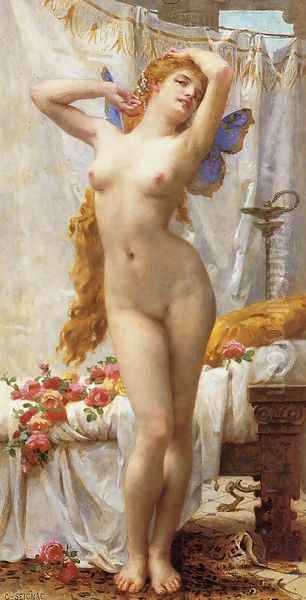
A tangible marker of his personal connections within the art world is the life-size bronze bust created by his friend, the sculptor Pierre Antoine Laurent. Housed in the Musée des Beaux-arts in Rennes and inscribed "Ami Seignac" (My friend Seignac), it serves as a poignant reminder of the artist's life and the relationships he formed. Ultimately, Seignac's legacy is that of a dedicated and highly skilled practitioner of French Academic painting, an artist who successfully upheld classical ideals through periods of artistic turmoil, leaving behind a body of work admired for its elegance, technical brilliance, and enduring vision of beauty.
Conclusion
Guillaume Seignac (1870-1924) remains a notable exponent of late French Academic Classicism. Emerging from the rigorous training of the Académie Julian under masters like William-Adolphe Bouguereau, he dedicated his career to upholding the traditions of idealized beauty, mythological and allegorical themes, and meticulous technique. His paintings, often featuring graceful female figures draped in his signature transparent veils and set against classical backdrops, earned him recognition at the Paris Salon and success in the international art market. While contemporary avant-garde movements charted radically different courses, Seignac skillfully navigated the established art world, creating a body of work admired for its elegance, craftsmanship, and evocative power. His art continues to find appreciation among collectors and serves as a testament to the enduring allure of classical ideals rendered with consummate Academic skill.